|
Shortly after
11am members of the Society met at the Blackburn Museum & Art
Gallery, Museum Street, Blackburn to meet Nick Harling the
Keeper of Community & Social History. The main purpose of the
visit was to have a private viewing of the Tockhoses hoard of 59
silver coins dating from the late 12th to early 13th century.
They were found in 1973 by our own society member Stuart Whalley
and his friend Richard Forkasiewicz. Before seeing the coins
Nick gave us a very informative tour of some of the museumís
exhibits, how it came about and some information of the museumís
main benefactors. |
|

'Laying of the foundation Stone of the Blackburn Cotton
Exchange' by Vladimir Sherwood (1863) |
|
The very first
work acquired by the Museum was on June 9th 1875. The painting
'Laying of the foundation Stone of the Blackburn Cotton
Exchange' by Vladimir Sherwood was purchased by the Committee
for the sum of £17 9s 6d. It is a magnificent view of Blackburn
in 1863 and Nick explained that many of the dignitaries in the
painting have been identified.
The committee responsible for building the Museum include the
great and the good of Blackburn; Alderman James Thompson, Thomas
Lewis (father of TB Lewis, who gave the Lewis Textile Museum),
Adam Dugdale; businessman, reformer and leader of the
Conservative party, James Lund cotton manufacturer; Sir William
Henry Hornby, MP and local councillor and Alderman Henry Livesey,
engineer and industrialist. Their likenesses are captured for us
to see on the carved stone panel outside the museum, paid for by
their illustrious selves. The names Edward Hart and Thomas Boys
Lewis in particular are recalled with particular gratitude.
Their gifts to the people of Blackburn include a splendid
collection of rare books and manuscripts, Japanese prints and
the Lewis Textile Museum. |
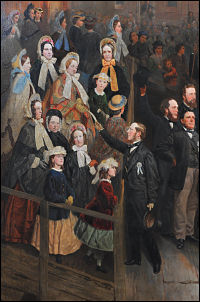
a detail from the painting |
|

Nick Harling explains how the
Lewis Textile Museum came about. |
With massive
industrial expansion in the cotton industry in the 1800s there
was also unrest as working conditions varied considerably. In
1826 local handloom weavers smashed new machinery in the mills
to try and protect their livelihood. In the 1840s a radical
group known as the Chartists demanded political reform to
improve the working conditions. In 1842 strikes turned to revolt
and a rowdy mob clashed with the army in Darwen Street. Soldiers
fired into the crown and many were injured. The last major
uprising was 1878 when a trade slump caused wages to be cut by
10%. A large mob attacked the Wilpshire home of Colonel R.
Jackson, chairman of the Association of Cotton Manufacturers,
burning it to the ground. The event was celebrated by various
issues of pottery showing drawings of the destruction. However,
within a month the unions accepted the wage cut and the strike
was broken. The industry recovered and by 1905 Blackburn was the
most productive weaving town in the world. The industry began to
decline after WW1 as many cotton supplying countries did their
own weaving with machinery partly supplied my Blackburn
manufacturers. |
| Nick then brought
out the two trays of silver pennies which was the main purpose
of the visit. |
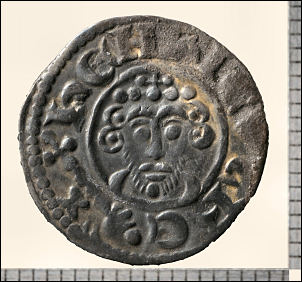
one of the silver pennies |
|
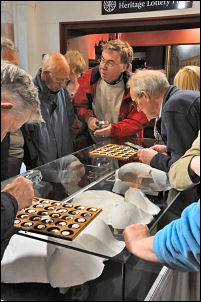
the Tockholes hoard
|

Some of the Lewis Textile museum exhibits |

The Museum's magnificent main staircase. |
|
One of the main
benefactors of the museum was Thomas Boys Lewis. He was born at
Billinge House, Blackburn, in 1869, being the youngest child of
Thomas and Ann Lewis. Educated at Eton and King's College,
Cambridge, he graduated first class in the Classical Tripos,
entering the cotton trade in 1892 in association with his
brother Henry. Before he finally retired into private life, he
had guided the firm's destiny for 28 years. |
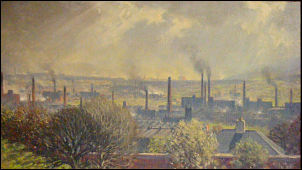
Mill Hill and Darwen by Sir Charles Holmes |
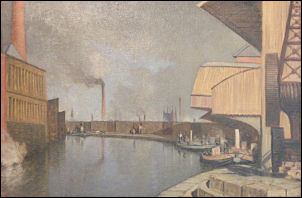
Canal Offices by Sir Charles Holmes |
The
preservation of Samlesbury Hall is another achievement due to
his generosity and public spirit.
He called in an old school-fellow, Sir Charles Holmes, formerly
Director of the National Gallery, to paint a series of ten oils
and thirty-three water colours with which to decorate the walls
at the Hall. They are mostly of industrial, canal and mill
scenes around Blackburn. Some are on display in the Great Hall,
Samlesbury Hall. |